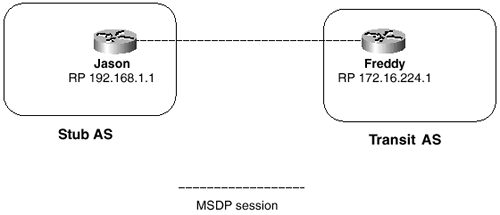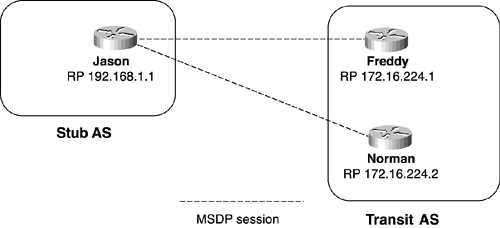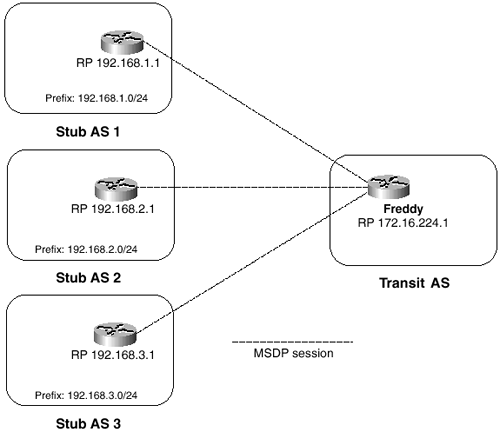Case Study: MSDP Default Peers
| If an AS is a stub or nontransit AS, and particularly if the AS is not multihomed , there is little or no reason to run BGP to its transit AS. A static default route at the stub AS, and a static route pointing to the stub prefixes at the transit AS, is generally sufficient. But what if the stub AS is also a multicast domain and its RP must peer with an RP in the neighboring domain? The overview of the MSDP operation explained that MSDP depends on the BGP next -hop database for its peer RPF checks. You can disable this dependency on BGP with the ip msdp default-peer command. MSDP just accepts all SA messages from default peers. Figure 7-18 shows a simple example. Here, the stub AS is peered to the transit AS by a single link. RPF checks are not necessary, because there is only one path and therefore no possibility of loops . Figure 7-18. BGP Is Typically Not Run Between a Stub AS and Its Transit AS, but This Can Cause a Problem for MSDP Example 7-19 shows the MSDP configuration of the two routers. Example 7-19 MSDP Configurations for Routers Jason and FreddyJason ip msdp peer 172.16.224.1 connect-source Loopback0 ip msdp default-peer 172.16.224.1 _______________________________________________________________________ Freddy ip msdp peer 192.168.1.1 connect-source Loopback0 ip msdp default-peer 192.168.1.1 A stub AS also might want to have MSDP peering with more than one RP for the sake of redundancy, as shown in Figure 7-19. SA messages cannot just be accepted from both default peers, because there is no RPF check mechanism. Instead, SA messages are accepted from only one peer. If that peer fails, messages are then accepted from the other peer. The underlying assumption here, of course, is that both default peers are sending the same SA messages. Figure 7-19. Jason Is Connected to More Than One Default MSDP Peer Example 7-20 shows the configuration for Jason. Example 7-20 Configuring Jason to Have Redundant Peering with Both Freddy and Normanip msdp peer 172.16.224.1 connect-source Loopback0 ip msdp peer 172.16.224.2 connect-source Loopback0 ip msdp default-peer 172.16.224.1 ip msdp default-peer 172.16.224.2 Under normal circumstances, the active default peer is the first peer in the configuration ”in this case, 172.16.224.1. SAs are not accepted from 172.16.224.2 unless 172.16.224.1 fails. The RP in a transit AS is likely to have more than one default MSDP peer, as shown in Figure 7-20. Just listing the default peers, as was shown in the preceding example, does not work, because SAs would be accepted by only a single peer. To cause the RP to accept SA messages from multiple peers while still providing loop avoidance in the absence of a peer RPF check, BGP-style prefix lists are used. The RP then accepts SA messages from all of its default peers, but only for source prefixes allowed by each peer's associated prefix list. The underlying assumption here is that each AS is using distinct prefixes, so loop avoidance is ensured. Figure 7-20. The RP in the Transit AS Has Three Default MSDP Peers Example 7-21 shows the configuration for Freddy. Example 7-21 Configuring an RP to Accept SA Messages from Multiple Peersip msdp peer 192.168.1.1 connect-source Loopback0 ip msdp peer 192.168.2.1 connect-source Loopback0 ip msdp peer 192.168.3.1 connect-source Loopback0 ip msdp default-peer 192.168.1.1 prefix-list AS1 ip msdp default-peer 192.168.2.1 prefix-list AS2 ip msdp default-peer 192.168.3.1 prefix-list AS3 ! ip prefix-list AS1 seq 5 permit 192.168.1.0/24 le 32 ip prefix-list AS2 seq 5 permit 192.168.2.0/24 le 32 ip prefix-list AS3 seq 5 permit 192.168.3.0/24 le 32 |


